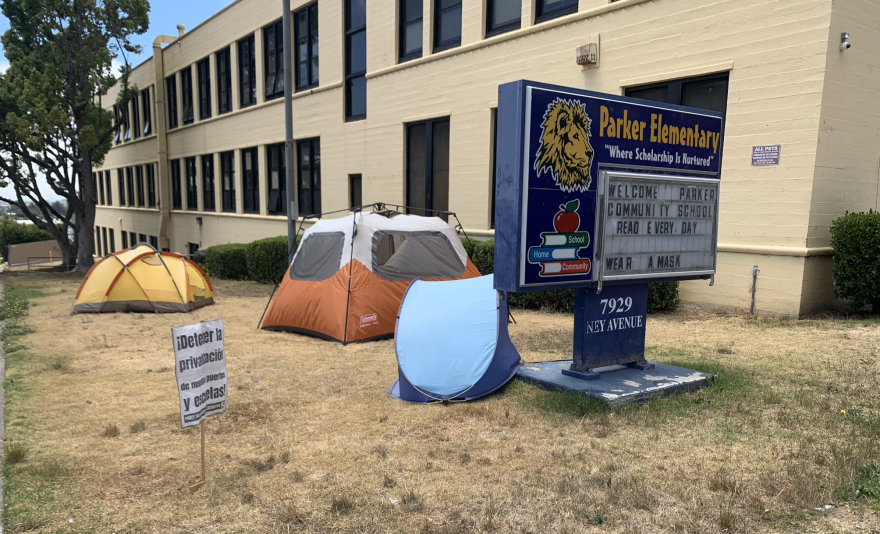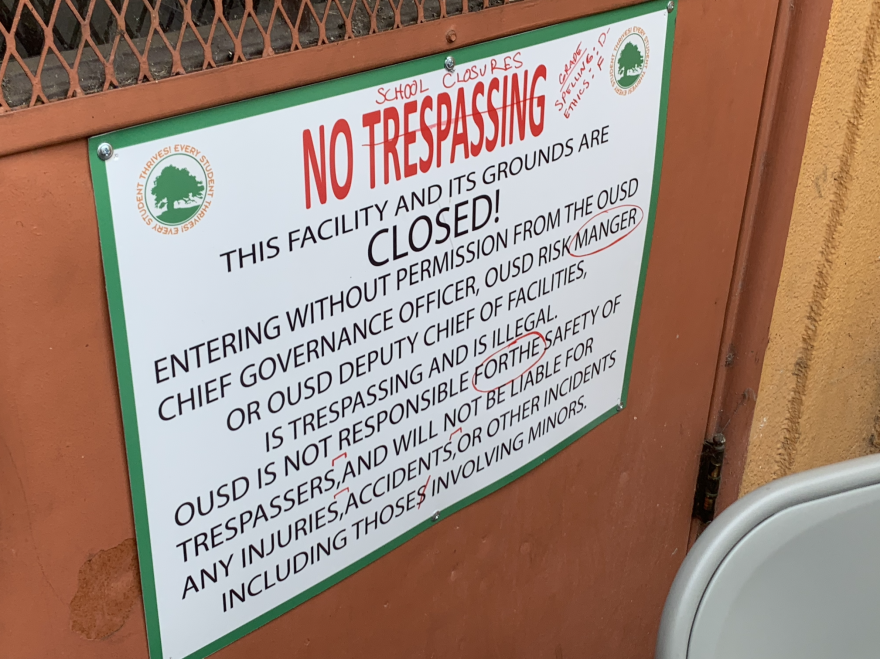This story most recently aired in the June 26, 2023 episode of Crosscurrents.
In a school in East Oakland, a dozen kids fill a classroom and learn how to make jewelry. The sharp sound of beads knocking against each other fills the space. The walls hold posters and show off class assignments. June Nelson and Kaye Mraz lead the class, circling around the tables as kids ask for help.
“Does anyone need a tray so the beads don’t go flying away?” asks June.
A chorus of young voices say “Me!” A bead slips from one of their small hands and bounces under their seat.

It might seem like any other school running a summer program. There are the classes you expect like math and reading and art. And there are the classes that might surprise you a little – like coding or filmmaking. But what’s happening here is not your run of the mill summer school programming because according to the Oakland Unified School District, or OUSD Parker K-8 doesn’t exist right now.
School, Interrupted
In February of this year, OUSD announced that they were planning on closing, merging, or truncating grades in 11 schools over the next two years.
“It was a huge blow,” says Azlinah Tambu. She’s a single mother to two daughters who have been attending Parker K-8 for years. “I had never considered my kids going to any other school. We live in the area. We can walk here very quickly and the school has been there for 100 years.”
Azlinah was just one of many Parker parents left blindsided - like Rochelle Jenkins. Rochelle is a working mother of three kids who went to Parker. Her son Jayvien, graduated into high school two years ago but her two daughters, Zoraya and Zariah, still have a few years of middle school left.
“They only gave us ten days to decide,” says Rochelle. “We didn't get to do our research on these other schools. Nothing.”
That message in February was the first time that either of them even heard the words school closure. That was shocking for Azlinah.
“They had absolutely no way to know how much this would affect us,” she says. “No surveys were done. No parents were contacted.”
Parker K-8 is the only OUSD public school of its kind in its East Oakland neighborhood. It serves a majority black population of nearly 300 students - 92 percent of whom are low income. That was all going to change.
Beyond the upset to their daily routines, Rochelle and Azlinah also feared for the safety of their children as they relocated to a school further away, outside their neighborhood.
According to Rochelle, “These kids have to walk through war zones every day just to get to school safely.” She explains that, on these longer commutes, her children and the children of her neighbors could encounter human trafficking, drug trafficking, gangs.
OUSD did not communicate with her about what transportation would look like for her kids after they closed Parker K-8. “It ain’t safe,” she says.
And it didn’t feel like an option, either. Azlinah and Rochelle knew something needed to be done. Even though they had attended school board meetings and tried to make their voices heard, they made little progress.

For Azlinah, the reality of all that would be lost to Parker’s closure came to a head on the day of her daughter’s fifth grade graduation.
Azlinah recalls the ceremony. “All of the kids were crying. They were holding on to each other. Nobody wanted to leave because they knew the school would be closed.” That was the moment that Azlinah knew that she had to stay.
And so, even as the celebrations died down and families and staff filtered out of the building, Azlinah and her kids remained. From the school, Azlinah called Rochelle and Rochelle called for even more help from the community.
“That’s when everything started to grow into what you see here today,” says Rochelle.
The Community’s School
Since May 25th, Rochelle and Azlinah and a number of other educators, parents, and community members have continued to stay at the school running classes, feeding kids, and organizing community events. From the ashes of Parker K-8, emerged the Parker Community School.
If you visit the campus, today you can see protest signs all over the front grounds decorated with colorful flowers. By the marquee, there are empty tents, orange and blue - a symbol of the sit-in.

I catch up with June, who runs a lot of the academic programming for younger kids at Parker, before class one morning. She’s working on a model for her lesson that day. She tells me about it.
Over the past few weeks, the students have been reading articles about what’s happening at Parker and talking through their own experiences as well. Today, they are finally writing their own stories. June is excited to hear about what the kids will write.
“When we've been having discussions about this stuff,” June says, “they literally say it's racist for them to be closing these schools and not closing schools like in the hills where white people live.”
That’s not the first time OUSD has been accused of racism. In April of this year - the ACLU filed a complaint with the California Department of Justice and asked them to investigate the district’s school closure policy, which disproportionately impacts Black students.
All seven schools slated for closure by OUSD over the next two years serve anywhere from 94 to 100 percent minority students. Four of them are majority black.
OUSD says these closures are happening because they are unable to afford sustaining smaller schools with lower enrollment. But according to Director Mike Hutchinson, who has been on the school board since 2020, the district is not in financial crisis.
“Right now, we have already approved a budget for next year that is not a deficit budget,” he says.
Before he became a school board member, Director Hutchinson had spent much of his life working in Oakland public schools. He was actually at Maxwell Park and Santa Fe Elementary when they were slated for closure by the district – along with 3 others – in 2012.
Director Hutchinson says that the narrative about budgeting is misleading. He says that the district has a lot of COVID relief dollars, and also more money coming in from the state surplus as well.
“This is Austerity Measures 101,” he says. “And, when we’re talking about a public education system, you know, I don’t buy that.”

On June 29, at the last board meeting of the school year, Director Hutchinson pleaded with his colleagues.
“This is their last chance, their last chance, their last chance to do the right thing.”
Families and neighbors lined up in the echoey elementary school auditorium; the energy was tense but hopeful.
During public comment many impassioned speeches were made. “You can vote with your heart,” said one community member.
“Please wrap it up,” responded District 4 Director Gary Yee.
With a 4-2 vote, the decision to close schools was reaffirmed.
Communities Post-Closure
For Azlinah - her fears about the school closure - go far beyond just her family.
“The best way to remove a whole community is first removing the kids, closing a school,” says Azlinah.

This spring, Stanford researchers Francis Pearman and Danielle Marie-Greene published a paper that assessed how school closures shaped neighborhoods in the years that followed. They found that gentrification was more likely to occur in neighborhoods where majority-black schools closed.
Pearman says that’s because – to the people responsible for gentrification, schools in black neighborhoods are actually thought of as dis-amenities, that are more appealing when closed.
“Black schools and black neighborhoods,” says Pearman, “can be understood in some ways act like safeguards against gentrification.”
Lakeview Elementary was another majority black school closed by OUSD in 2012. Joel Velasquez had children there when the district shut it down. Joel recalls what his neighborhood felt like after the closure.
“My youngest daughter, that didn't get a chance to go to Lakeview, literally, was like, Well, Dad, I thought they closed the school. Why can't we play there? So not being able to enter that space after that point,” says Joel, “was just as traumatizing, if not more.”
Before Lakeview was shut down, however, Joel led the charge to try to save it. Like at Parker today, they kept the school open to run classes and feed children. But that occupation only lasted for 17 days.
Director Hutchinson was also present at the 2012 sit-in. He recalls how it ended. “The police finally came and kicked us off. Joel decided he wanted to leave in handcuffs and everyone left.”
What’s Next?
The Parker Community School has been operating for more than two months at this point – far longer than the Lakeview sit-in.
It’s unclear if – or when -- the school board will force them to truly shut their doors.

For now, OUSD drops by weekly to conduct tours of the school. At one of the last ones, it was pointed out that there was a padlock on one of the exit doors, that’s a fire hazard.
According to June and other volunteers, however, that lock has been there for years – way before Parker K-8 became Parker Community School.
“That door's never been used because the district closed that and locked it and now all of a sudden it's a hazard,” June says.
So there are no plans to leave just yet. To Rochelle, it’s simple: “I feel like If we don't care about the community, then who will? We can't depend on the people at the top to do it.”



